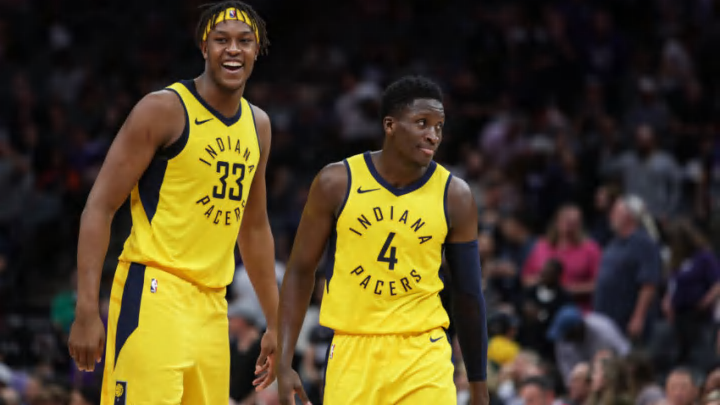The Whiteboard is The Step Back’s daily basketball newsletter, covering the NBA, WNBA and more. Subscribe here to get it delivered to you via email each morning.
Every NBA team has their hall of horrors — their draft busts, missed trades, ill-timed injuries and cruel twists of fate. There’s no real way to quantitatively compare and rank this sort of misery but suffice it to say the Pacers had had as much as anyone.
The Victor Oladipo-era is almost certainly coming to a close. The writing was kind of on the wall, even if Oladipo had tried to paint over it with meaningless platitudes about how he just wanted to win. Yesterday’s report that he had, in front of teammates, asked players on the Heat and Knicks if he could come play with them was ugly. Whether it was true or not, or maybe just a bad joke taken out of context, it got worse when Oladipo’s sister subtly called out Myles Turner on social media as the spreader of fake news. All that reporting mostly drowned out the detail that the Pacers have reportedly explored trade scenarios involving both Oladipo and Turner.
To be clear, this is not the framework of a contender that is being disrupted. But it’s still a promising core being rolled back to some earlier stage of rebuilding. And it’s another All-Star player, one who had been adopted as a local hero, deciding he’d rather be somewhere else. Remember, Oladipo was the unexpectedly valuable return that came from the Paul George trade, a scenario that is uncomfortable echoed by the situation with Oladipo.
Why do the Pacers keep building good teams only to watch them fall apart?
George, of course, was the centerpiece of a legit contender (non-LeBron category) and paired with Roy Hibbert to form one of the most efficient defenses in NBA history. That group cracked under the pressure of LeBron and internal and interpersonal friction, and their demise was hastened by George’s catastrophic broken leg. And of course, the genesis of that core was three-fold: 1) Danny Granger (an All-Star, elite defender and 20-point scorer) rapidly declining because of knee injuries, opening space for George to become a star; 2) Trading the pick that became Kawhi Leonard to the Spurs for George Hill; and 3) Trading a broken-down Jermaine O’Neal for the draft rights to Roy Hibbert.
O’Neal, of course, was the last vestige of the Pacers’ near dynasty of the early 2000s. That dynasty was disrupted, not just by the Malice at the Palace, but by Ron Artest’s request for time off to promote his rap album, by Stephen Jackson firing a gun in the air after an altercation at a strip club, O’Neal’s ailing knees and Reggie Miller’s age-related decline. Smack in the middle of that era was Jonathan Bender, who the Pacers traded up to draft at No. 5 in 1999, their first top-five pick since 1989. Bender was a 7-foot wing with star potential, whose career was derailed by nagging knee injuries before he turned 23.
By my rough estimation, that’s four distinct eras — O’Neal-Artest, Danny Granger, Hibbert-George, and Oladipo — two of which had legit championship aspirations. Through injury, exceptional events, and broken personal relationships, all four came apart at the seams. That’s five or six All-NBA caliber players who were never filly able to realize their potential in the context of this team. Again, fans of every team can do this same exercise and roll out an exposition just as heart-rending. The power of entropy is universal. Still, it feels like the Pacers might be due for some cosmic, karmic progression to the mean.
#OtherContent
With the NBA’s salary cap being a staple of free agency conversations right now, Micah Wimmer reviews a new book that takes a look at how it came to exist in the first place.
The 2020 NBA Draft is finally upon us, and Trevor Magnotti has his final Big Board prepared. The top prospect may be a surprise.
